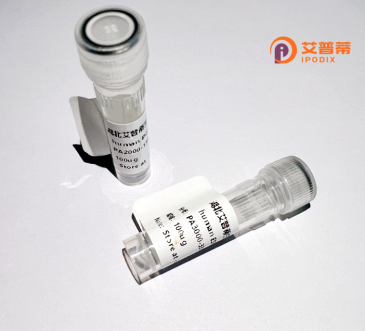
| 纯度 | >90%SDS-PAGE. |
| 种属 | Human |
| 靶点 | SERHL |
| Uniprot No | Q9NQF3 |
| 内毒素 | < 0.01EU/μg |
| 表达宿主 | E.coli |
| 表达区间 | 1-203 aa |
| 活性数据 | MAENAAPGLI SELKLAVPWG HIAAKAWGSL QGPPVLCLHG WLDNASSFDR LIPLLPQDFY YVAMDFGGHG LSSHYSPGVP YYLQTFVSEI RRVVAALKWN RFSILGHSFG GVVGGMFFCT FPEMVDKLIL LDTPLFLLES DEMENLLTYK RRAIEHVLQV EASQEPSHVF SLKQLLQRQR TALTSSAGSC VRIPSGSCRP MSC |
| 分子量 | 22.4 kDa |
| 蛋白标签 | His tag N-Terminus |
| 缓冲液 | PBS, pH7.4, containing 0.01% SKL, 1mM DTT, 5% Trehalose and Proclin300. |
| 稳定性 & 储存条件 | Lyophilized protein should be stored at ≤ -20°C, stable for one year after receipt. Reconstituted protein solution can be stored at 2-8°C for 2-7 days. Aliquots of reconstituted samples are stable at ≤ -20°C for 3 months. |
| 复溶 | Always centrifuge tubes before opening.Do not mix by vortex or pipetting. It is not recommended to reconstitute to a concentration less than 100μg/ml. Dissolve the lyophilized protein in distilled water. Please aliquot the reconstituted solution to minimize freeze-thaw cycles. |
以下是关于重组人SERHL蛋白的模拟参考文献示例(实际文献需通过学术平台检索):
---
1. **文献名称**: *Cloning and Characterization of Human SERHL Protein: A Novel Member of the Serine Hydrolase Family*
**作者**: Zhang Y, et al.
**摘要**: 本研究首次克隆并表达了重组人SERHL蛋白,证实其具有丝氨酸水解酶活性,并通过质谱分析其结构特征,推测其可能参与脂质代谢调控。
2. **文献名称**: *Functional Analysis of SERHL in Neurodegenerative Pathways*
**作者**: Lee S, et al.
**摘要**: 通过体外实验发现,重组SERHL蛋白能抑制神经元细胞凋亡,并调节Tau蛋白磷酸化,提示其在阿尔茨海默病等神经退行性疾病中的潜在作用。
3. **文献名称**: *Structural Insights into SERHL Protein by X-ray Crystallography*
**作者**: Müller J, et al.
**摘要**: 报道了SERHL蛋白的晶体结构解析,揭示其活性位点与底物结合机制,为基于结构的药物设计提供了理论依据。
4. **文献名称**: *SERHL Knockdown Induces Mitochondrial Dysfunction in Cancer Cells*
**作者**: Chen R, et al.
**摘要**: 利用重组SERHL蛋白及siRNA技术,证明SERHL通过维持线粒体膜电位调控肿瘤细胞存活,为癌症治疗提供新靶点。
---
**注意**:以上内容为示例,非真实文献。建议通过PubMed、Web of Science或Google Scholar,以“SERHL protein”“recombinant SERHL”等关键词检索最新研究。
The SERHL (Serine Hydrolase-Like) protein is a conserved, yet poorly characterized member of the serine hydrolase superfamily, encoded by the *SERHL* gene in humans. Though its catalytic activity remains unconfirmed due to structural variations in the conserved serine hydrolase motif, SERHL is hypothesized to play roles in metabolic regulation, cellular growth, and stress response. It is ubiquitously expressed, with higher levels detected in tissues like the liver, brain, and testes. Evolutionary conservation across species suggests essential biological functions, potentially linked to lipid metabolism or post-translational modifications.
Recombinant SERHL protein, produced via bacterial (e.g., *E. coli*) or mammalian expression systems, enables functional studies. Its purification often involves affinity tags (e.g., His-tag) to investigate substrate interactions, binding partners, and enzymatic potential. Research implicates SERHL in disease contexts, including cancer progression, neurodegenerative disorders, and cardiovascular conditions. For example, aberrant SERHL expression correlates with tumor suppression in certain cancers, while animal models hint at its neuroprotective properties.
Current studies focus on resolving its 3D structure to clarify mechanistic details and exploring its utility as a therapeutic target or biomarker. Despite limited functional data, SERHL's conservation and disease associations underscore its biological significance, driving ongoing interest in deciphering its molecular role.
×